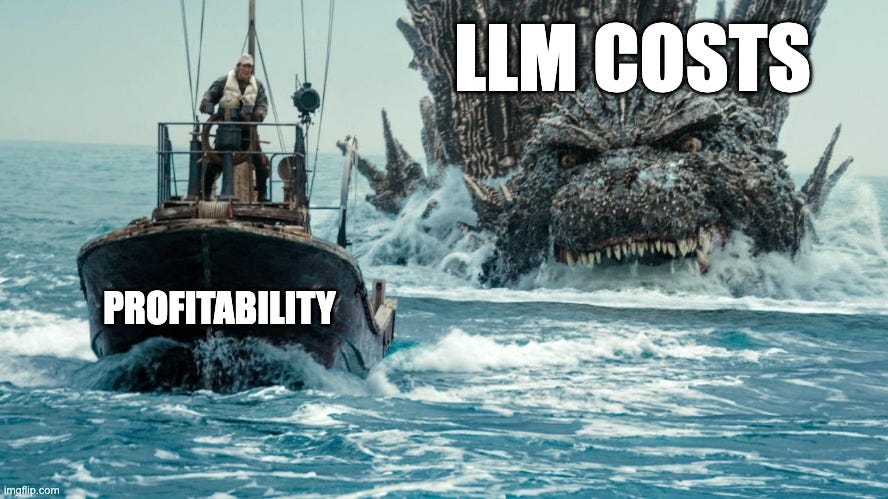My beef with AI credit pricing
But it is a necessary evil - for now.
With new technology comes new pricing models, but oof, do I hate the one we’re all using right now: AI Credits.
This post is brought to you by Factors.ai: Marketers spend hours optimizing ads. But the biggest wins come from fixing what happens AFTER the click. If your conversions aren’t feeding back to LinkedIn, your performance is capped. That’s why Factors.ai helps you connect the LinkedIn Conversions API and is giving away $1,000 in LinkedIn ad credits when you do.
It’s not that I don’t understand how we got here. SaaS has printed money for decades with hugely profitable products that had almost no marginal cost. Aside from server costs (you’re welcome, AWS), it doesn’t cost me anything to send my app to a new user.
AI is different. Wayyyy different. Using LLMs is expensive and each usage costs real money. Which means that companies are doing a credits-based system to make sure that usage doesn’t spike horribly out of control and bankrupt them.
So I get it. But that doesn’t mean I have to like it. I do not. In fact, I hate it. Here’s why:
Reason #1: Customer doesn’t know the price up front
You have no idea how much each action costs. I want to do something with an AI tool and, in my mind, it has this much value attached to it. But the LLM may be quite expensive for that action, so it’s often surprising. Lack of predictability is always bad when it comes to pricing, which deters a lot of customers from trying things out. But even more importantly, it leads to reason #2:
Reason #2: Prices don’t feel fair
Partially because of this, customers constantly feel like they’re being taken advantage of. Their perception of how much credits should cost is very different from how much compute power it actually takes for the LLM to perform that action. Sometimes it’s “Oh, that only costs this many credits? That’s crazy!” Sometimes it’s “Oh, yikes, if I knew it was going to cost that many credits, I wouldn’t have done it.” But either way: you always find out about it in retrospect, not up front. Super annoying. This creates so much dissatisfaction and lots of angry customers.
Reason #3: There’s no apples-to-apples comparison
You can’t compare how much things cost, across different companies. With other products, if you think, “Hey, this company is ripping me off.” … Fine, no worries. You go to a competitor. But with AI products, every company creates their completely arbitrary definition of what ‘credit’ means - and nobody shares how their credits are defined. Some companies will say “A credit equals an LLM token.” Some say 10 LLM tokens is one credit. Some say a thousand. Some give you unlimited ‘slow’ LLM… how slow is it? nobody knows. So, it really starts to mess with customers’ heads… credits have become a completely made-up metric.
This means that, as a customer, you can’t really compare two businesses anymore in terms of which provides more value. No good.
Reason #4: Customer Support becomes impossible.
All of this makes the Support job impossible. The customers are constantly writing in, venting their frustration. Either trying to figure out how much a plan will cost… or complaining about the fact that their existing usage wasn’t worth it. Which just makes the Support role even more unbearable on top of what it is.
Reason #5: Companies will exploit this confusion.
This is a big one. This whole system creates very bad incentives for companies that are not trying to do right by their customers. Because it’s a completely obfuscated and made-up metric, if you just want to make more money, you just make credits cost more. Or, you make the actions cost more credits, so a customer will eat up credits faster and buy more of them.
Terrible. It’s kind of like the Google model: ‘Oh, we need to make more profits, let’s increase cost of our ads.’ For an AI company: ‘We need to make more profits, let’s make each action cost more credits.’
Just to clarify: I haven’t personally seen this happening. At Lovable, we actually have the exact opposite, which I absolutely LOVE… we’re constantly trying to make each action cheaper, in terms of credits. Just a month ago, there was a big discussion about the fact that our actions have become 20-30% cheaper, because we codified some of the things and improved how we send instructions to LLMs. That was a big deal! Everyone celebrated. It’s an ongoing thing where, internally, we’re trying to see how we can make it more efficient.
But I know that companies with the wrong incentives will take advantage of this situation. If it helps bail out some leader who’s not hitting their forecast target, it’s only a matter of time. That one will only be more exploited in the future.
So, how long will AI Credits last?
Yep, Credits are miserable, but there doesn’t seem to be a viable alternative right now because LLM costs are just toooooo high. So the question is: How long will they stick around?
I think it will stay as long as LLMs are expensive. But! We have to believe that the costs are going to come down. And when the costs come down, I actually think we’ll revert back to our good-old models of per-user pricing, or something concrete that is measurable and transparent. We just need this crazy cost dynamic to go away.
And it doesn’t even have to go all the way away: Even when we move to 50% profitability - not even close to where we’ve been, with 70-90% profitability - we’ll start to see companies reverting back to our good ole’ monetization models.
I predict that the companies who are able to revert back to our current monetization models are the ones who will win the space overall. The ones that are rigid with their credits system are going to be the losers… customers will churn because of the price unpredictability, or their perception of the value they’re getting through these made-up metrics.
In the meantime… if you hear of a better model, let me know!
Edited by Jonathan Yagel, meme padawan.






Thought quite a lot about this topic, agree with pretty much everything you wrote. Incentives become so incredibly skewed towards the customer.
But! As the data center infrastructure is being built out and the inference becomes more cost efficient, it feels like that one player will figure out the financials and take the step to switch to something more aligned.
Then, the competitors will be forced to follow, because that player will simply start winning on market share.
I imagine the pricing follow a quite similar path to the internet:
1. Usage based (billed per time spent)
2. Subscription based (unlimited usage)
3. Tier based (speed tiers)
Simplify of course, but paints the picture.
All this hedges on competition in the foundation model space staying fierce of course, which I think today seems quite likely.
It’s also impossible for customers to be efficient using credits. If I want to use fewer credits, I have little control and motivation.